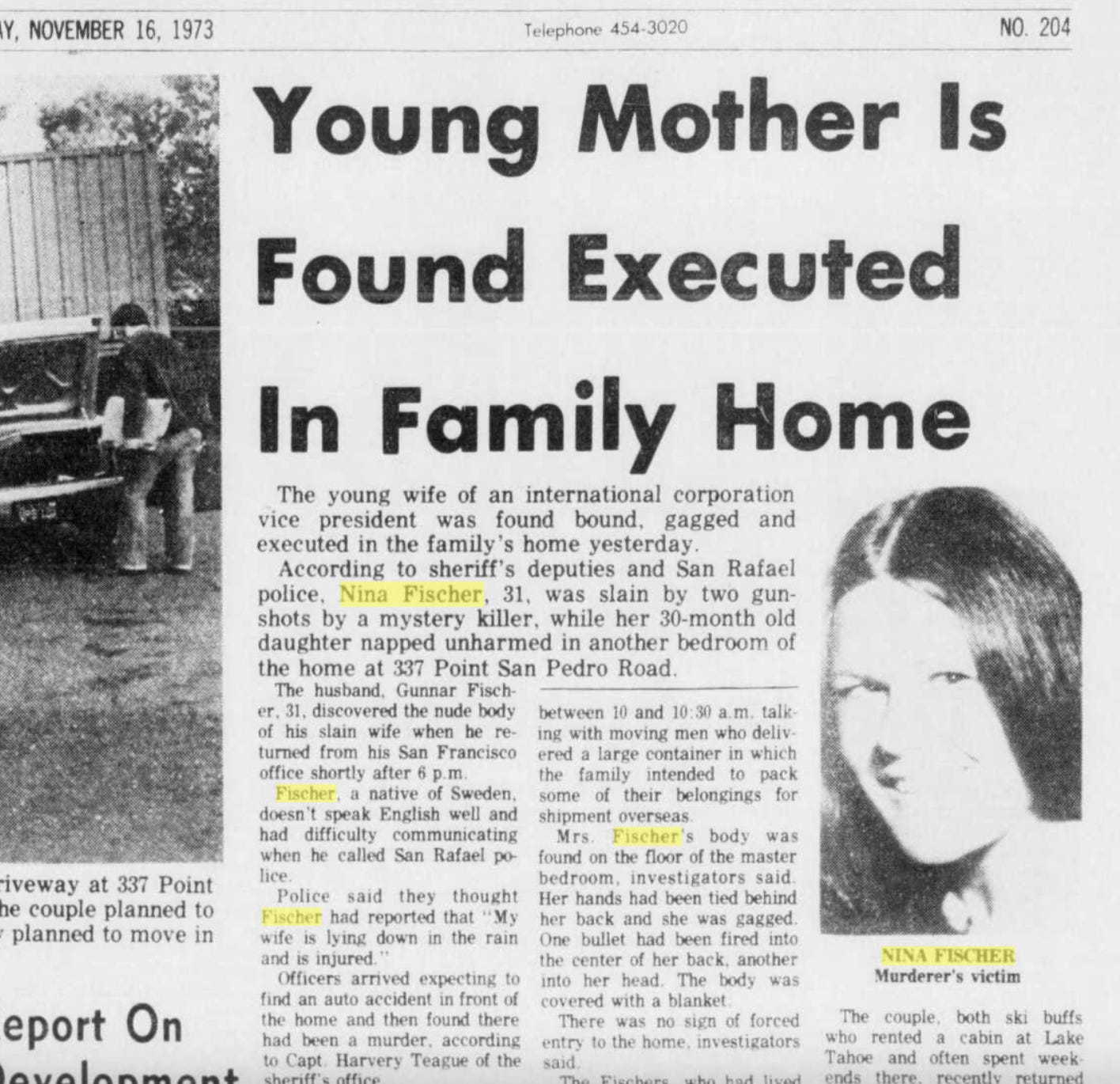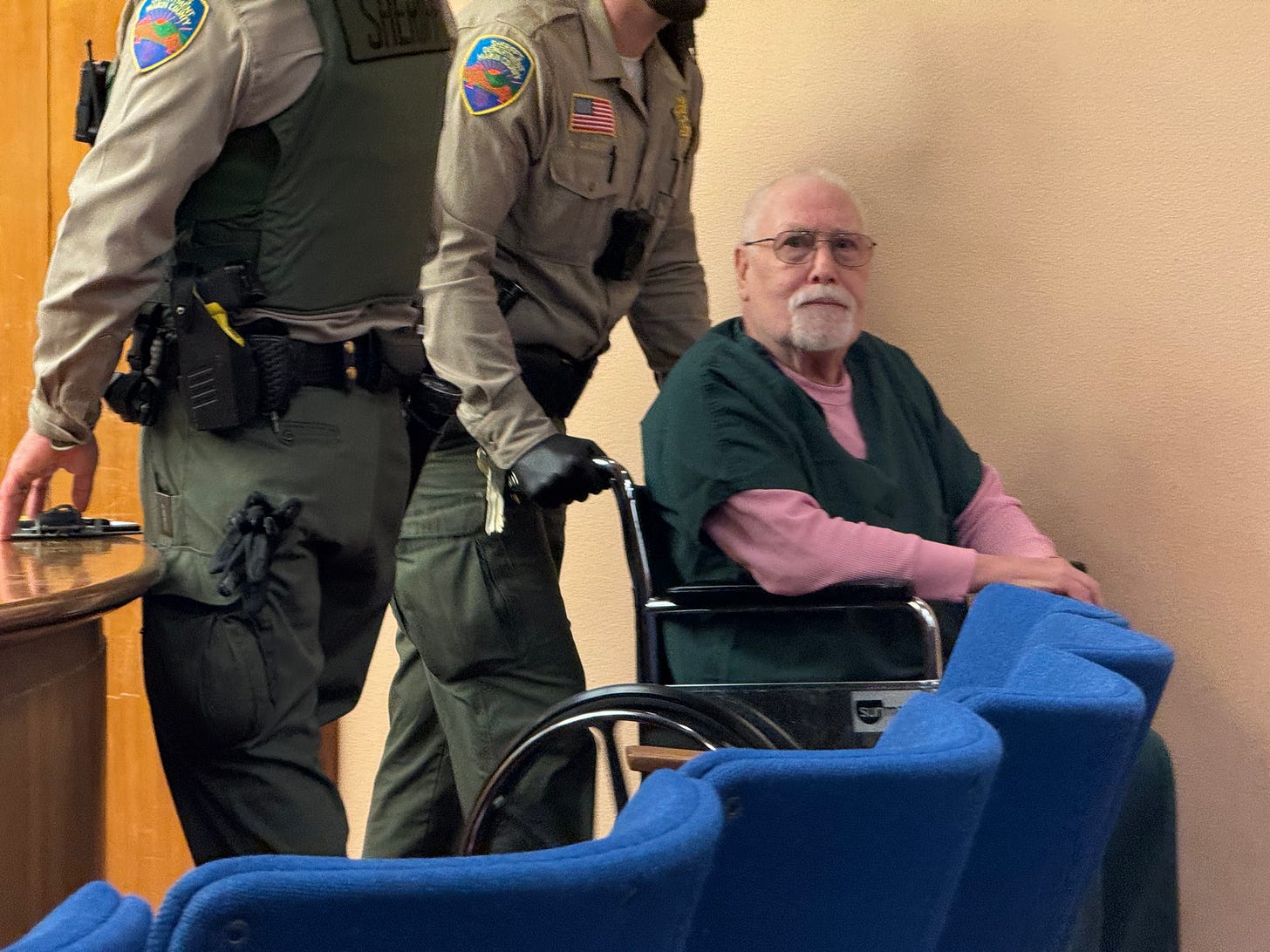On a gray November day in 1973, the young Swedish mother Nina Fischer was found brutally murdered in her home in San Rafael. It was her husband, a vice president at Coronaverken, who discovered her body when he returned from his office in San Francisco. Now, a suspect is finally being brought to trial.
November 15, 1973 – California
In their home on Point San Pedro Road in San Rafael, 31-year-old Nina Fischer packs boxes for the family’s return to Sweden. Her two-year-old daughter is with her. Perhaps Nina dreams of the future, and the opportunity to use her training as a physical therapist in her home country. She and her husband, Gunnar, have been married for seven years and have spent most of that time in the United States—first in New York and then three years in California. The active young couple often visits a rented cabin at nearby Lake Tahoe for skiing and outdoor activities. But now they decide it’s time to return to Sweden.
Later in the day, a moving company arrives to deliver the container that will transport the family’s belongings to Sweden. Neighbors see Nina speaking with the movers outside the house. Shortly afterward, a salesperson knocks on the door, but no one answers.
Gunnar spends the day at his office on Market Street in San Francisco. He is vice president for Coronaverken, a major Swedish company expanding abroad under the name Corona International Corporation. The family has two phone lines at home: one private and one tied to the company. Gunnar tries several times during the day to call Nina to check on the packing, but no one answers on one line, and the other is constantly busy.
Across the street from the Fischers' single-story house lies San Francisco Bay, and further down the road is one of California’s oldest marinas, the Marin Yacht Club. The area is idyllic but partially under development. Nearby is a shopping center with a pizzeria featured in George Lucas’s debut film American Graffiti, which premiered just three months earlier.
When Gunnar fails to reach his wife, he leaves work earlier than planned. Perhaps he drives a little too fast over the Golden Gate Bridge and through the remaining 20 minutes to their home.
The scene that greets him is a brutal nightmare. Nina lies dead in the couple’s bedroom, her hands bound and her mouth taped. She has been sexually assaulted, shot several times, and left naked under a blanket. Newspapers described it as an "execution." The couple’s two-year-old daughter is unharmed in another room.
Police later stated that they initially had trouble understanding what had happened because Gunnar didn’t speak English—a claim that seems strange given that he has lived and worked in the U.S. for several years. Most likely, it’s the shock that makes him unable to communicate clearly during the first emergency call.
Police thoroughly search the house, collect fingerprints, and try to determine the motive for the murder. There are no signs of forced entry, and although Nina’s purse is missing, more valuable items are left untouched. The two movers who had been at the house earlier that day are questioned by police but cleared of suspicion.
The murder garners significant attention in the American press. Both Nina and Gunnar are named, and he is described as a "Swedish business executive." In several articles, Nina is referred to as "Nadine," though her family in Sweden will later state that no one ever called her that.
Despite an extensive investigation, police hit a dead end. A $2,000 reward is offered for tips leading to an arrest. Anonymous tips can be sent by mail, and tipsters are encouraged to tear off a corner of their letter to later claim the reward without identifying themselves. But despite a flood of tips, the case remains unsolved. The evidence is archived, and the case becomes one of many so-called cold cases.
In Sweden, media coverage of the case is more sparse. Not even the Swedish-American publication Vestkusten, which was distributed in California at the time, mentions the murder. Gunnar and his daughter return to Sweden, where Nina is buried. A small death notice is published in Dagens Nyheter, briefly announcing that Nina Fischer, born in 1942, has passed away in San Rafael, USA.
2021 – Marin County
Two retired prosecutors, Paula Kamena and Linda Witong, volunteer to review unsolved cases, or "cold cases," dedicating a few hours a week to the effort. Advances in DNA technology and other tools create new possibilities, but reviewing evidence carefully is critical to determine which cases are worth sending for analysis.
Among the cases the team reviews is the tragic 1973 murder of a young Swedish mother.
“In this specific case, the Cold Case team noted that we still had preserved DNA that could be compared with DNA profiles in the system,” says Sergeant Adam Schermerhorn, public information officer for the Marin County Sheriff’s Office.
The preserved DNA evidence is sent to the California Familial Search Program, launched in 2008 to help law enforcement identify familial connections between crime scene DNA and profiles in a database. The program is used primarily in serious crimes, such as murder and sexual assault, and is subject to strict privacy regulations.
The case had been reopened once before, according to police.
“At that time, no matching DNA was found. The goal now is to see if anyone whose DNA has since been added to the database is a match or a relative,” Schermerhorn says.
This time, the analysis yields results. After months of investigation, detectives find a lead. While it isn’t a direct DNA match, a relative is identified, providing a starting point for a new, intensive investigation.
August 2024
After three years of investigative work, 75-year-old Michael Eugene Mullen is arrested at his home in Lemhi County, Idaho, approximately 1,000 kilometers (over 600 miles) from San Rafael. Supported by DNA evidence, he is charged with murder. Due to medical reasons, Mullen is taken to a hospital before later being transferred to a detention center near San Francisco.
According to police, Michael Eugene Mullen was not part of the original investigation in 1973. However, he reportedly lived in nearby Sonoma County and worked in San Rafael at the time of the murder. It is unclear whether Mullen and Nina Fischer knew each other.
In October, the first preliminary hearing is held at Marin Superior Court, just a few minutes drive from the house in San Rafael where the Fischer family lived. The defendant is too ill to attend in person and participates via Zoom.
At the next court date in December, the defendant appears in the courtroom for the first time. He has long gray hair, is dressed in green prison clothing, and sitting in a wheelchair. His eyes appear alert and sharp. It is decided that the trial can begin at the start of the following year.
January 2025
Shortly after 9:30 a.m., the defendant is wheeled into the courtroom, where the judge greets him. He wears the same prison clothing as at the last hearing.
The defendant appears to be having hearing or other difficulties, requiring his attorney, Peter Kuykendal, to lean in and explain what had been said in court. During the proceedings, the defendant is expected to inform the court whether he pleads guilty or not guilty to the murder committed over 50 years ago.
However, his attorney instead requests a competency evaluation to assess if his client is able to go through normal court proceedings. The judge approves the request.
The next hearing is scheduled for early February when the medical report is expected to be delivered.
Comments from Prosecutors and Family
Paula Kamena, one of the prosecutors in the Cold Case group, says that she can not comment on the case at this time.
“I understand the significant interest in this tragic case, but since the facts have not yet been presented in court, it would not be appropriate for me to answer any questions at this stage,” Kamena said.
The family has expressed gratitude for the work being done to bring resolution to the case but has chosen not to make any statements to the media until a verdict has been reached.
The writer has published a Swedish version of the article in Aftonbladet. https://www.aftonbladet.se/nyheter/a/vgbKQl/mordet-pa-svenska-nina-31-nara-losning-efter-51-ar







